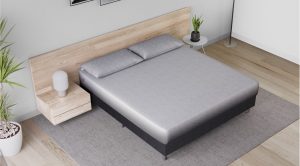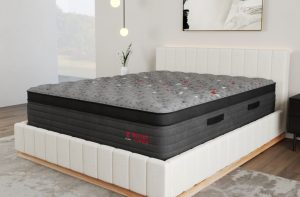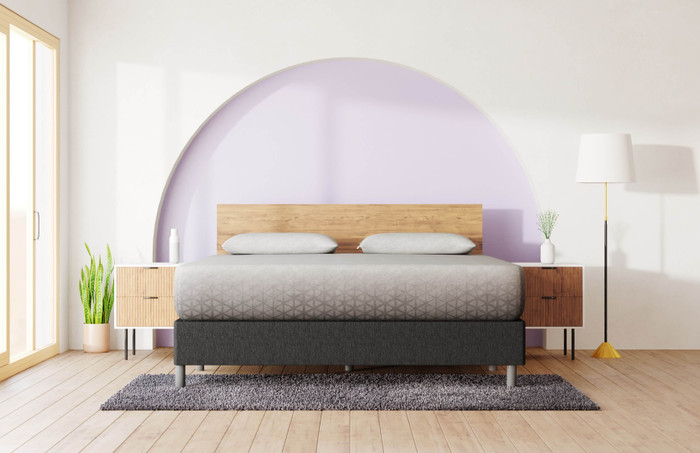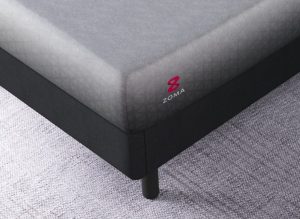Best Mattress for Arthritis
Studies indicate that as many as 80 percent of people with arthritis have difficulty sleeping. And because not getting enough sleep can aggravate existing pain, arthritis sufferers may find themselves stuck in a vicious cycle of losing sleep to pain and waking up with even more pain.
A mattress can’t cure arthritis, but it can soothe the symptoms. The best mattress for someone with arthritis can leave them better rested and waking up with less pain.
Best Memory Foam Mattress for Arthritis: Zoma Mattress
 When we designed our Zoma Mattress, our focus was on creating a bed to promote body recovery and restorative sleep. A sleeper with arthritis can benefit greatly from both. Our Zoma Mattress is 11 inches tall and consists of three foam layers and a mattress cover.
When we designed our Zoma Mattress, our focus was on creating a bed to promote body recovery and restorative sleep. A sleeper with arthritis can benefit greatly from both. Our Zoma Mattress is 11 inches tall and consists of three foam layers and a mattress cover.
The top layer is 2 inches of gel-infused memory foam. We use gel memory foam to provide a cooling mattress for hot sleepers and a soft, conforming surface for pressure relief.
The first layer also has our unique Triangulex™ technology. We include triangle-shaped cutouts in the shoulders and leg areas of the mattress for extra pressure relief and airflow.
Next is 2 inches of our Reactiv™ foam. Reactiv™ has a similar feel to latex, adding some bounce and responsiveness to the mattress.
The third and bottom layer is 7 inches of our Support+ foam. Support+ forms the mattress’s core and keeps the bed in shape.
The mattress cover is made with polyester and stretchy elastane for better airflow.
A Zoma Mattress costs $699 with free shipping. A Zoma Mattress comes with a 10-year warranty to protect against structural defects, such as sagging beyond an inch. A sagging mattress compromises support and leads to a painful night of sleep.
Customers get a 100-night sleep trial to try out the mattress at home. If you’re unhappy with the Zoma Mattress after 30 nights of trying it out, you can return it for a full refund.
Best Hybrid Mattress for Arthritis: Zoma Hybrid
We designed the Zoma Hybrid to provide the same restorative benefits as our classic memory foam mattress. Though the hybrid has a different constructions, it shares some similarities with the original Zoma Mattress.
The hybrid has four layers encased in a soft, breathable mattress cover made with an elastic polyester-blend fabric.
Two inches of gel memory foam provide the bed’s comfort layer. The memory foam molds to your body for pressure and pain relief, while the infused gels keep you cool.
The gel foam also includes triangle-shaped cutouts in the head and foot of the mattress for airflow. These cutouts also promote more pressure relief by increasing the foam’s flexibility, allowing the bed to contour better to your body.
The hybrid’s second layer contains 2 inches of Reactiv™ foam. Reactiv™ adapts to your movements and prevents you from sinking too deeply into the mattress.
Seven inches of pocketed coils support the mattress. We encase every coil in a packet as a buffer against motion transfer. If the mattress contained unwrapped coils, your every movement could ripple across the mattress.
An inch of base foam rests underneath the coils. This sturdy surface enables the coils to stand up straight, instead of sagging prematurely.
A queen size Zoma Hybrid is $999 with free shipping and returns. Every Zoma Hybrid mattress includes a 100-night sleep trial and a 10-year warranty. Our warranty offers coverage for any indentations that exceed an inch.
Best Soft Mattress for Arthritis: Zoma Boost
 The plush surface of the Zoma Boost feels gentle on the joints, providing exceptional comfort and support for sleepers, including those with arthritis. With its innovative design, the Zoma Boost is engineered to reduce pressure on your joints, helping to alleviate pain and provide a comfortable night’s sleep.
The plush surface of the Zoma Boost feels gentle on the joints, providing exceptional comfort and support for sleepers, including those with arthritis. With its innovative design, the Zoma Boost is engineered to reduce pressure on your joints, helping to alleviate pain and provide a comfortable night’s sleep.
The mattress has a special cover that keeps you cool and comfy throughout the night, with quilted soft foam underneath. The cover is made to feel refreshingly cool and light, like a silky coat of snowflakes. Next is a layer of graphite memory foam to hug the body and deepen the mattress’s cool feel.
The foam top of the Zoma Boost is bolstered by the transition layer of Reactiv™ foam. These three foam layers also help distribute your weight so you won’t wake up feeling uncomfortable or in pain.
The Zoma Boost has a core of pocketed coils that adapt to your body, so you get the responsive support you need for a good night’s sleep. This helps keep your spine in a healthy position, so your body won’t experience strain or misalignment that can make arthritic pain worse.
Like all Zoma mattresses, the Zoma Boost features CertiPUR-US® certified memory foam and comes with free shipping, a 100-night sleep trial and a 10-year warranty.
What is Arthritis?
Arthritis means “joint inflammation” and is typically an umbrella term used to describe more than 100 different joint disorders. These include osteoarthritis, rheumatoid arthritis, fibromyalgia, and gout.
Osteoarthritis is the most common type of arthritis among older adults and is one of the most common causes of disability. The condition develops as the cartilage-cushioning in bone joints wears away, and it often worsens over time. More than 30 million adults in the U.S. have osteoarthritis.
Rheumatoid arthritis is an autoimmune disease, which means the immune system attacks healthy joint tissue because of faulty T cells. This tissue damage can create chronic pain issues, make it difficult to walk, and cause deformities.
Fibromyalgia causes pain and tenderness all over the body. People with fibromyalgia may be more sensitive to pain.
Gout is a common and painful type of inflammatory arthritis. It causes attacks of pain and swelling in the joints and typically starts in the big toe. The condition can flare up or worsen into gouty arthritis.
Arthritis can cause permanent joint changes and make it difficult or even impossible for a person to do their day-to-day activities. Certain kinds of arthritis can also affect the eyes, lungs, heart, kidney, and skin.
There are many factors that increase your chances of developing arthritis. Some are controllable, but a few are not. Risk factors for arthritis include:
- Age: The risk for most types of arthritis increases as you get older and joints wear out.
- Gender: Women are more likely to develop most kinds of arthritis. An exception is gout, which men are more likely to develop.
- Genetics: Certain genes can increase your likelihood of developing some types of arthritis.
- Joint injury and overuse: Repetitive stress and overuse can damage a joint and increase the likelihood of osteoarthritis.
- Obesity: More weight means more stress on joints.
- Infection: Infected joints can become arthritic. . Talk to your doctor if your joints are swollen, red, or feel warm.
- Diet: A diet high in purines (an organic compound found in most meat and some vegetables) or fructose can increase the risk of gout.
- Pregnancy history: Women who have never given birth are at greater risk of developing rheumatoid arthritis.
What Arthritis Sufferers Need from a Mattress
Many people with arthritis can find it difficult to fall asleep. Aside from any chronic pain symptoms, they may have another condition such as insomnia.
“What is the relationship between pain and sleep?” says Dr. Nayantara Santhi. “Sleep and pain have a two-way relationship. Poor sleep can intensify the pain and conversely, pain can worsen sleep. A good sleeping position can help relieve pain, and a good mattress or pillow can go a long way in facilitating this.”
“The ambient temperature plays an important role in sleep. Generally, a cooler temperature facilitates sleep. Not surprisingly, it is not just the room temperature but also the temperature regulation of our mattress that is important. A breathable cool mattress like the Zoma memory foam mattress may be helpful for sleep.”
“Poor sleep posture is one of the underlying causes for sleep disturbances at night. A bad mattress such as a sagging one can result in a different loading of the human spine and thus lead to bad sleeping posture. A supportive mattress such as the Zoma hybrid can help with this problem.”
The right mattress can help make it easier to fall asleep, but there are certain features it should have.
Pressure Relief
Pressure relief may be the most crucial feature in a mattress for a sleeper with arthritis. Many arthritis sufferers have inflammations that can cause pressure build-up or sensitivity. The right mattress will contour to the body for full pressure relief.
Our recommendation for a pressure-relieving bed is a memory foam mattress, as no other type of mattress can match its ability to meet every curve of a sleeper’s body.
Support
A supportive mattress keeps the spine in a neutral position. If a bed is too soft or too firm, the spine is likely to become misaligned, causing pain.
Support doesn’t just come from a mattress. The right foundation can add to your bed’s support and feel, and help keep your mattress in shape for many years to come.
One of the best foundations for a sleeper with arthritis is an adjustable base. An adjustable bed frame lets you choose a position for better circulation and pressure relief. It can also be easier to sit up and get out of bed with an adjustable base, perfect for sleepers who find it difficult to move from pain or joints swelling.
A good foundation should also make it easier to get in and out of bed by keeping your mattress at the right height. To determine if your bed is at the right height, sit on the edge. Your feet should rest flat on the floor and your knees should be aligned with your hip.
Responsiveness
Responsiveness refers to the ease with which a bed adapts to your movements. A bed that’s slow to respond can impair movement and leave a sleeper feeling trapped. An unresponsive bed can leave you tossing and turning, searching for more comfort.
Softer mattresses tend to be less responsive, as are beds made with low-quality foams. A medium feel mattress often strikes the right balance between responsiveness and comfort.
Temperature Control
Many people with arthritis are more sensitive to temperature. Some mattresses contain dense foams that trap body heat, which can lead to discomfort. A mattress with cooling features can better absorb and dissipate body heat for a better night of sleep.
Mattress Types
A pressure-relieving bed is essential for someone with arthritis, to prevent additional pain and stiffness. Up to 88 percent of those with chronic disorders complain about their sleep, with insomnia as a particularly common complaint. Reducing pain can help an arthritis sufferer get a good night’s sleep. Some mattress types can ease pain, while others may worsen it.
Memory Foam
The bed in a box mattress trend advanced memory foam mattresses’ popularity, but they remain popular because of their many special features. Memory foam is one of the best materials for pressure relief, as the material can fit itself to the body like a second skin. Memory foam also prevents motion transfer and makes no sound as a person moves, which can keep a restless sleeper from disturbing others.
Memory foam beds can be the right mattress for an arthritis sufferer. The material can trap heat, so we recommend looking for added cooling agents such as graphite, gel, copper, charcoal, or even plant-based foams.
Latex
Latex is a contouring material like memory foam, but it can be more durable and breathable. It’s also an eco-friendly material, as the rubber sap used in natural latex mattresses is harvested without cutting down or damaging the tree.
As a latex mattress has many similarities to a memory foam mattress, it can provide the same relief for an arthritis sufferer. However, the material is not without its drawbacks. Latex mattresses can be some of the more expensive and heavy mattresses on the market. It also can be firmer than shoppers expect, and a too firm mattress may aggravate chronic pain.
Innerspring
An innerspring mattress is made with a coil support base and a pillow top or Euro top (a pillow top is sewn on top of the mattress, while a Euro top is under the top cover and looks more uniform). The coils of an innerspring let air flow through, but can be rough on the joints of an arthritis sufferer. An innerspring’s coils may also start sagging within a few years, causing more pain as the mattress’s support is lost.
We do not recommend an innerspring mattress for a sleeper with arthritis, as they typically cannot provide the pressure relief and motion isolation needed to sleep well. If you enjoy the feel of an innerspring mattress, consider a hybrid or find an innerspring mattress with a thick quilted pillow top and wrapped coils to reduce motion transfer.
Hybrid
A hybrid mattress merges the traits of innerspring and foam mattresses. There are at least 2 to 3 inches of foam (typically memory foam) and a coil support layer underneath. Most hybrids use coils wrapped in foam or fabric for better pressure relief and motion isolation.
A hybrid can provide good pressure relief, but it will not match the pressure relief of a good memory foam or latex bed. Like innerspring mattresses, hybrids face the problem of sagging coils after five or so years.
Sleeping Position
Your sleeping position not only affects the type of mattress and firmness option best for you, but it can also determine how much pain you wake up with each morning. No matter the position, your spine needs to remain neutral.
Side Sleeping
A side sleeper’s mattress needs enough plush cushioning for their shoulders and hips to sink into it. A mattress that keeps the shoulders and hips on top can cause the spine to shift out of alignment. However, a too soft mattress can cause more pressure to build up, so a mattress for a side sleeper needs to feel just right.
A soft to medium mattress suits most side sleepers, as firmer mattresses typically fail to provide needed pressure relief. If you’re a side sleeper who is uncertain what to do with their arms, try hugging a body pillow or bolster pillow as you drift off to sleep.
Back Sleeping
Back sleeping is one of the best positions to minimize pressure on the spine. If one of your arthritis symptoms is frequent back pain, you may want to give back sleeping a try. Keeping a wedge pillow under your knees will help prevent lower back pain.
A mattress for back sleepers should be medium-firm to firm. If you want a softer bed, a medium bed with zoned support may suffice. Avoid too soft a bed, as it may misalign your spine or cause pressure to build up in your back, hips, and knees.
Stomach Sleeping
We do not recommend stomach sleeping, particularly with a chronic pain issue such as arthritis. Gravity often pushes a stomach sleeper’s lower torso into the mattress, stretching the spine out of its natural curvature. This can cause or aggravate chronic back pain.
For those who love the position, a firm mattress and a second pillow under the abdomen can help keep the spine in its neutral alignment. A stomach sleeper should also sleep with a thin pillow under their head, or even skip the head pillow.
Mattress Firmness
Firmness describes how the mattress feels— how soft or firm is it? There are many different firmness levels, to better suit the wide variety of sleepers.
Many mattress brands use a firmness scale to decide how firm a mattress is. The firmness scale runs from 1 to 10, with 1 as the softest and 10 as the firmest. The scale can be subjective because of different materials and brands, so before you buy a mattress it’s a smart idea to scan customer feedback and mattress reviews to see if anyone received a firmer or softer bed than they expected.
Sleeping position isn’t all that determines your right firmness. Your body type also affects how your mattress feels. A sleeper who weighs less than 130 pounds may prefer a soft mattress, while a sleeper weighing more than 230 pounds may do better on a firmer mattress.
Some mattresses come with firmed-up edges, known as edge support. Edge support can make getting in and out of bed easier if you live with chronic pain. However, edge support reduces your available sleeping surface. Edge support can also raise a mattress’s price and wear out before the rest of the mattress does.
Sleep Trial, Warranty, and Return Policy
Buying a mattress means more than just purchasing a bed to sleep upon. When you buy a good mattress, you’re also buying the sleep trial, warranty, and return policy tied to it. We highly recommend buying a mattress with all three attached, as their presence can indicate if a mattress is a high-quality product or not.
Sleep Trial
Many mattresses, particularly online mattresses, come with a sleep trial period. A sleep trial lets you try out a mattress at home, and if you don’t like it, you can return it for a full refund. Many sleep trials last between 90 to 120 days, though you’ll find a few that last a year.
Warranty
A warranty is the company’s guarantee that a customer won’t have to buy a new mattress if it has a defect. How long a warranty lasts can be a sign of the mattress’s craftsmanship and likely durability.
A good mattress warranty covers repair and replacement costs entirely during the first 10 years, with no hidden fees such as transportation fees. However, it’s not uncommon for a warranty extending past 10 years to be prorated, meaning you will pay part of the costs to repair or replace your mattress based upon its original price.
Return Policy
Reading the return policy before you buy lets you know how to initiate a return and the condition your mattress must be kept in to be eligible for a return. Many mattress companies won’t take back a dirty, stained, or otherwise unfit mattress. Some companies won’t take back the mattress if it’s been opened or will only take the mattress back if it’s been damaged on delivery.
A return policy can also substitute for a sleep trial. We recommend looking for a mattress that lets you make a return within the first 30 days, as this is the time most need to adjust to a new mattress.
Tips For Better Sleep
Living with arthritis can be difficult. Many people with arthritis also have a sleep disorder, such as insomnia or restless legs syndrome. Even the best mattress can only do so much in helping you get a better night of sleep. If you have trouble falling asleep, following our tips can improve your sleep hygiene.
One big tip is to do all that you can to avoid going to bed with pain. Take a warm bath or shower before bed to ease any aches or stiffness. Avoid activities in the evening that cause or aggravate pain.
Establishing a bedtime routine can help you get in the habit of falling asleep at the same time every night. It’s crucial to stick with your standard bedtime and wake time even on weekends and vacations, as abandoning your routine can cause your sleep quality to suffer when you resume it. Relying on time management tips can help you make the most of your day and feel less stressed at night.
Your bedroom’s setup can also help you sleep better. Keeping your bedroom temperature in the 60-degree range can make it easier to fall asleep. The right temperature is different for everyone, so don’t be afraid to adjust the thermostat if you’re too hot or too cold.
Make sure your bedroom is kept tidy as well, as clutter can distract you from falling asleep.
Additionally, avoid caffeine and electronics before bed. Caffeine keeps you awake and so does the bright light of an electronic screen. We advise staying away from caffeine up to 6 hours before bed, and your electronics should be turned off at least an hour before bedtime. Yes, a memory foam mattress can be good for arthritis. It’s one of the best mattress types for pain relief, as the material contours to sensitive areas of the body for pressure relief. Look for a memory foam mattress with cooling features, to keep you from waking up sweaty. Yes, a bad mattress can cause you to wake up with all sorts of pain. Beds offer less support over time as their materials wear down. If you’re waking up with more soreness and pain than you fell asleep with, it’s probably time to replace your mattress. A good bed for someone with arthritis will be soft enough to mold to sensitive joints for pressure relief but supportive enough to keep the hips and spine aligned. A bed that’s too soft may hamper movement. The exact firmness that’s right for you will depend on your sleeping position, bodyweight, and personal preferences. Side sleepers with arthritis should look for a bed with pressure-relieving materials. Beds with memory foam or latex foam tops are a good choice because both foams contour to the body. A side sleeper's mattress should have a soft to medium feel.Frequently Asked Questions
Is a memory foam mattress good for arthritis?
Can a bad mattress cause joint pain?
Is a firm or soft mattress better for arthritis?
What kind of mattress is best for side sleepers?
Did We Help?
Arthritis will change your life, but with the right treatment plan you can manage your symptoms. A bedtime routine and a good mattress will help keep the pain down in the morning, so you can better go about your day. Talk to your doctor for more options, such as exercises you can do and what foods might be best for you.
This article is for informational purposes and should not replace advice from your doctor or other medical professional.
Andrew Russell, Wellness Writer 
Andrew Russell is a part-time writer and full-time sleep enthusiast. At Zoma, Andrew lends his sleep expertise and writes many of our “better sleep” guides. Outside of Zoma, Andrew puts his advice to the test, always trying new ways to get deeper, more restorative sleep. We appreciate Andrew because he doesn’t give advice that he doesn’t follow himself, so you can feel confident his solutions for better sleep really do the trick. Andrew's work has been featured on Ladders, Bright Side, and several other publications.
View all posts


